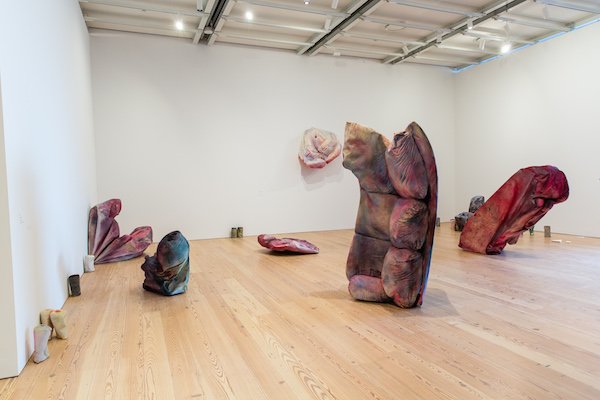Gesture, Craft, and Capitalism
by Emily Jaeger, Features Editor

I couldn’t help myself. I had to see the Whitney Biennial a second time, circling through the galleries until I was a bit dizzy with all the color and sound. I was partially enticed by the promise of a lens into the most contemporary of art—a one-stop-shop. The show was also fulfilling my dire need to meditate on the past year: if Colbert could make it funny, perhaps the Biennial could sculpt it, shape it into some visible form, maybe even shed light on the beauty (even if it was a painful sort of beauty).
The majority of Biennial reviews (including my own, part 1) hone in on the political nature of the exhibition, and the Whitney was certainly promoting it as such. However, amidst the cacophony of political messages and prophecies, a slightly quieter focus was emerging: the role of the artistic process, especially the artists’ mark. The question of the artists’ mark—or what is the X factor which makes an object art—is apt both because of the large amount of works which incorporate found objects and recycled materials, as well as a return, in other parts of the exhibit, to figurative painting.

In the entryway to the exhibit, Matt Browning’s series of wood grids, Untitled, initially recalls the anti-craft works of Minimalists such as Sol LeWitt and Donald Judd. Scattered throughout the exhibition, the grids highlight the empty spaces they contain, their blank faces a calm against the storm. However, their backstory suggests the opposite of anti-craft: all the grids were carved from a single piece of wood, in the tradition of master whittlers.

Similarly, Kaari Upson’s installation of abandoned couches reshaped and re-cast in urethane is the result of an arduous, even futsy, process. While the couches convey associations with the body, abandonment, and perhaps with a bit of humor, both Upson and Browning’s work depend on materiality and intense manipulation for artistic innovation. The success of the intertextuality (with a twist) between Browning and his Minimalist predecessors is predicated on the complexity of his artistic process.

Upson and Browning’s pieces fit in with many of the other works in the gallery in terms of process. Raúl De Nieves’s gallery includes sculptures made out of old shoes covered over with melted plastic beads. A favorite installation, “The Meat Grinder’s Iron Clothes” by Samara Golden, involves multiple dioramas of rooms furnished with handmade appliances, furniture, and accessories. Hung right and upside-down, the rooms, reflected through a series of mirrors, project a tribute the city: the image of an entire apartment building.

The labor-intensive processes of these works and even the necessity, for example, for Browning to publicly proclaim these processes, seems to assign a bit of false value to production. The rules of capitalism suggest that making new—such as suddenly involving couches in your artistic process—is necessary to continue to sell. And an anxiety to sell is a very present undercurrent of the exhibit.

Once again, Frances Stark’s work provides a helpful counterbalance. Rather than create new work, she chose to copy pages from Svenonius’s work Censorship NOW. Her only modification of the text (other than painting the text on gigantic canvases) was to include a painted version of marginalia: segments of the text have been underlined in dripping pink paint while in other places red underlining and blue stars suggest American flags. With these limited strokes, Stark reminds us of the great potential for meaning we can find in the most simple, basic gesture: the line.
The 2017 Whitney Biennial was on full display at the Whitney Museum of American Art from March 17–June 11; however, selected works are still on view through July 16th.
Copyright 2017 Woven Tale Press LLC. All Rights Reserved.

